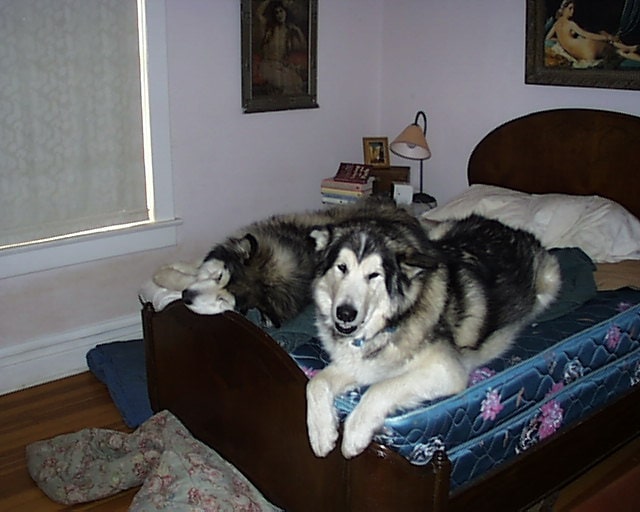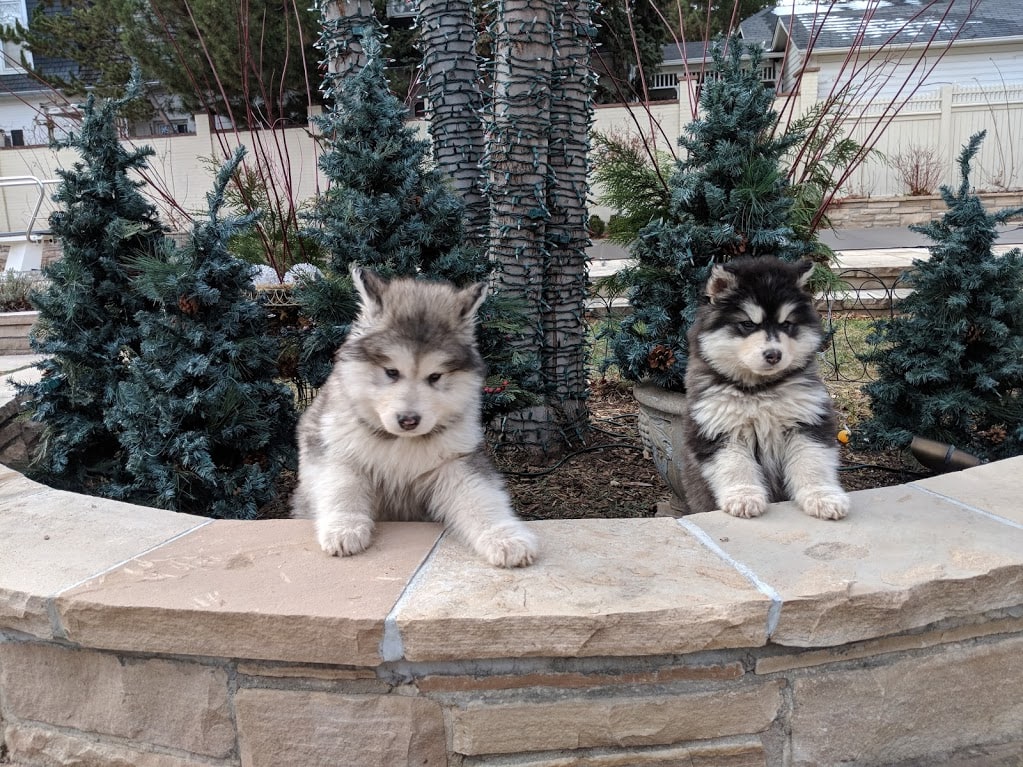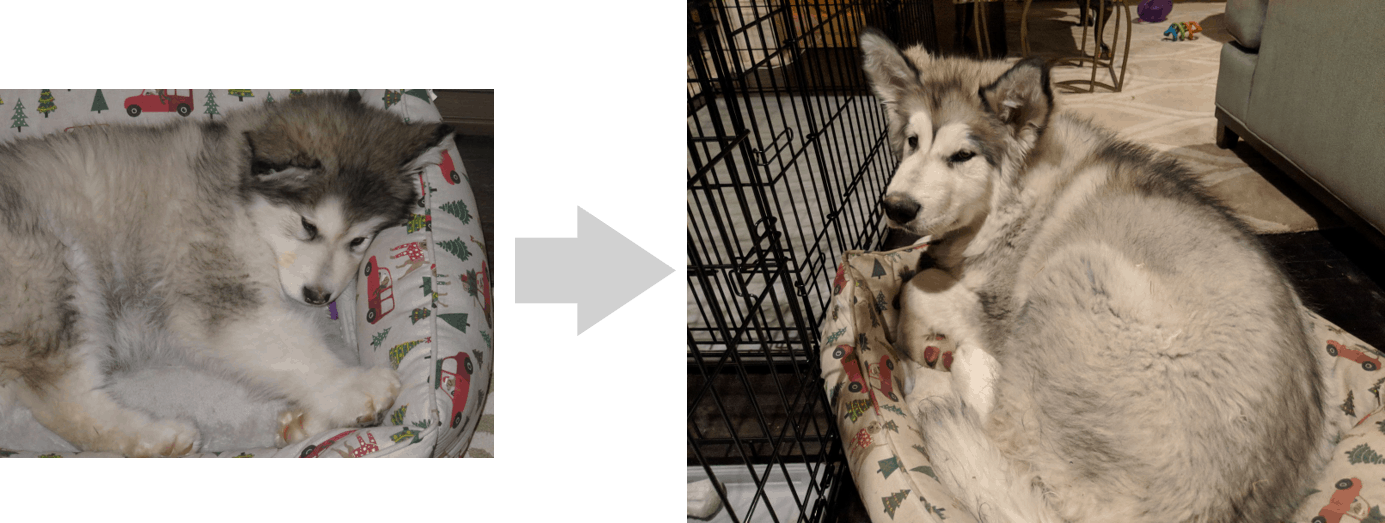What Raising Malamutes Can Teach Us About Medicine…
When I first moved to Boulder, Colorado, in the early ’90s as a new doctor, I was sold hook, line, and sinker on the rugged mountain lifestyle. Growing up in South Florida, which was merely another suburb of the New York metro area, decked out in Miami Vice pinks and pastels, Colorado and its amazing mountains were everything I had never experienced. Rock climbers wearing obscure brands of climbing gear were all over the place, and I felt a need to embrace my new home and become more “Colorado-like.” That somehow led to me being the pack leader of two giant Alaskan Malamutes and learning a lot about patient care in the process. Bear with me while I explain.
What the Heck Is a Malamute?
Believe it or not, Alaska has a state dog—the malamute (aka Alaskan husky). Picture a Siberian husky with brown eyes, but then increase the size some 2–4X. This is basically a stockier version of a wolf, bred by the Eskimos to pull heavy sleds and assist on seal hunts.
Stumbling into Malamutes on NPR
Let’s face it. For every married couple who wants to have kids, their first dog is their initial foray into the uncertain waters of child rearing. So it was with my wife and me. But which type of dog? Most choose a nice family-oriented breed, like a golden or a lab. However, we were in rugged Colorado wearing our newly purchased fleece (that was a “thing” in the ’90s), so our first surrogate child needed to be different.
One morning, I heard Daniel Pinkwater’s series on malamutes on the radio while going to work. He described his intense bond with the noble malamute “wolf dog,” and I was sold. This had to be our Colorado dog! This pet would be all of the types of rugged that I saw around me and everything my “Don Johnson” South Florida self was clearly not.
A Trip to the Kennel
I located a malamute breeder in the suburban mountains outside of Denver and we were off. That first visit to a malamute kennel can be pretty intimidating for the uninitiated. The dogs are huge and look like wolves, so there is a primal human instinct to run. They also tend to howl, randomly, like wolves, like they’re signaling each other on how best to take down a kill (which I was pretty sure would be me).
However, while malamute adults are huge, scary wolf things, the puppies are cute little fluff balls that look like living teddy bears, so it doesn’t take long to fall in love once the puppies come out. We had been told by friends to only get a female, so the breeder brought out the largest fluffy girl who was the alpha of her litter. However, there was also a male who was barely half her size and who just looked a little “runty.” She told us that she would throw him in for a hundred bucks if we wanted the pair. I was a sucker for not breaking up a family, so we went out to lunch for me to convince my wife that we really needed two dogs. She had all of the usual good reasons, like the fact that while I was at work she would eventually be taking care of two huge wolf dogs, but, luckily, I’m relentless. We took the pair.
Raising Wolves 1.0
Ever since ancient times, man has wanted to tame the wild, and this yearning was also at the heart of my malamute journey. Either that or I desperately wanted to have a dog who was as rugged and wild as my surroundings. Or just a cool dog. I’m still unclear today on those details.
What is true is that while malamute breeders will deny this on a stack of Bibles, M’loot malamutes are basically domesticated wolves bred to pull stuff. Every ancestral instinct that has been bred out of goldens, labs, labradoodles, and other family dogs is still present in malamutes in spades. In fact, you can’t successfully raise and own one until you fully understand this, but nobody tells you this stuff and there is no disclaimer you sign, but there should be.
For the first few months of owning these teddy bears, she would terrorize him. For example, every chance she got, she would run into and ram him, like a big ship ramming a little one. We would also hear little guttural growls as they played tug-of-war that didn’t sound dog-like. In fact, they sounded like wild animals devouring a rabbit, which should have been our first clue.
The Pack Hierarchy Is Everything
Daniel Pinkwater had alluded to the fact that for malamutes, understanding where you fit in the pack is as essential as breathing or eating and sometimes more important. While we all observe some watered-down version of this when we own more than one dog, for malamutes, this is very different. Think of a game of chess, but played with growls, nasty looks, and intermittent barroom brawls.
One example is what I call “The Hunger Games.” When malamutes eat, it’s often by pack order. Meaning that like wolves devouring a kill, the pack leader gets his fill first and then the beta and finally all the way down the roster until you finally get to the omega, who eats last. So our big female always ate first, and our smaller male wasn’t permitted to eat until she was done.
The Pack Order Is Not Fixed
As Daniel Pinkwater puts it, there’s nothing permanent about the pack order. In the wild, the alpha might get old or go blind, so while malamutes obey the alpha, they also challenge him or her periodically. Wolves are upwardly mobile, a bit like wolf executives climbing some corporate pack ladder. My first real taste of that came in the worst possible place, our local vet’s office.
While our male and female had gotten into scruffs over toys or food, he was very much submissive to her because of his smaller stature. When they were younger, all she had to do was to growl and he would back down. However, that changed on the day of their six-month checkup as the vet opened the door to the exam room.
If you’ve never seen malamutes fight, imagine two wild bears going at it full tilt over the last scrap of food on earth. So as the door swung open and the vet said “hi,” he lunged at her, and it was immediately obvious that this was a fight to the death. The vet wisely told me to stay out of it as I think she was as freaked out as I. In the end, he won and she lost, and as long as they lived, he always ate first and she always ate second. The pack order between them was established. The only question was, who would be alpha of the whole pack?
Trying to Be Alpha

I then chanced upon a super-strange training technique based on understanding the ancestral wolf called “Dog Talk.” Basically, you assert yourself as the pack leader and growl a lot. For example, when a dog in the pack steps out of line, the alpha growls as a warning. If the lower-ranked dog still doesn’t behave, a quick and non-injurious bite ensues. Finally, a dog that still doesn’t understand gets “taken down.” While biting your dog or placing him on his back may not sit well with the postive-reinforcement, treat-training crowd used to fawning golden retrievers, it worked miracles for our young wolves. They instantly began to fall in line.
Goldens and Then Our Second Set of Young Wolves
After our first surrogate children passed on, my wife didn’t want this much work, so we ended up getting a pair of goldens. They were cute and cuddly, and we came to love them, but they had none of the wild smarts of our malamutes. Recently, when one of our goldens passed on, I persuaded my wife to again go back to the noble wolf dogs of the north. Again, she brought up the obvious objections, like she would have to care for two growing wild animals while I was at work. Again, I am thankfully relentless. However, this time, things would be a bit more challenging.


This inability to walk them together and their frequent dominance scruffs caused my wife to take them to a local dog-trainer guru. Not understanding northern breeds and the nature of the pack as well as likely inserting a healthy dose of her own painful high-school experience, she thought they just didn’t like each other. In fact, you don’t get to not like another pack member, as in the wild this threatens the survival of the whole pack. The pack isn’t high school; it’s a finely tuned machine where each cog has its precise role. Right now two cogs are trying to figure out how they fit together.
Being the Alpha While Mushing the Sled Dogs
While my dog-talk magic that worked so well on the first two has some effect on Koda and Koko, walking them both at once and keeping them apart was still a nightmare. At five and a half months, he’s already three inches bigger and far stronger than our golden, and she’s close behind. Malamutes in weight-pulling contests can pull up to a ton, so even when you have two people walking them separately, they can easily impose their will.
The other night, my wife was exhausted, so she asked me if could walk them. I took a gulp and decided to walk them together. Could I do this?
Likely out of necessity, I started to act like I was mushing them as a sled driver. I overpronounced their names, yelling “KO DAHH!” and “KOO KOO!” when they got out of line, placing a big emphasis on that second syllable, which distinguishes the two. I also lightly hit their leash to give them a reminder. All of a sudden, we were like a sled team. They instantly “got it.” Makes sense; these are sled dogs.
In addition, the real key was that in my voice, I had total confidence. I seemed to know that my commands would be obeyed, and they knew it too. We now do this now every night, and every night when I walk in the front door unscathed and in one piece, my wife is amazed. This week I began to tie this to patient care.
Confidence Is King in Medicine
This all worked because they needed an alpha who could give them lots of direction in a format that they could instinctively grasp. This is a bit like seeing patients with complex problems. Patients, like my street-smart malamutes, instantly know when the doctor knows what he or she is doing or doesn’t have a clue.
A doctor who has extensive experience and knows how to interpret what the patient is feeling into an effective treatment plan is a valuable thing in pain medicine. Just ask any patient that has bounced around from doctor to doctor without getting answers. They immediately and instinctively know if the doctor knows what’s wrong with them or has no idea. I’ve heard this countless times from my patients. For example, I saw Dr. So And So, but within the first few minutes, I could tell he didn’t know what was wrong with me.
Patients also read confidence in their doctor’s voice or on his or her face. That confidence is key to having the patient feel comfortable, why they chose one doctor over another, and possibly if they get well or not. In essence, confidence in medicine is currency as real as drugs or procedures.
In regenerative medicine right now, there isn’t much experience. I see this all the time. A patient goes to a doctor who has completed only a few of these procedures, and he or she instantly picks up on the lack of confidence. They walk out of that office without scheduling for a stem cell or platelet procedure and instead go online looking for a clinic that has been doing this for a while. They ultimately chose Regenexx for this reason.
Working Within the Patient’s Context Is Critical
In the case of Koda and Koko, they needed something different than our first dogs. The same holds true with patients. The great Sir William Osler once said,
“The good physician treats the disease; the great physician treats the patient who has the disease.”
Meaning that the physician has to work within what the patient believes. One patient might like less-invasive care, and another may want to try anything to get the problem fixed. One might need a more alternative approach or need more hand-holding, while another is more pragmatic. In medicine, context is everything.
The upshot? Owning malamutes has been a great experience that has made that link between the civilized and the wild more palpable. Finally finding out how to be alpha to Koda and Koko has also made it clearer to me that confidence in dog mushing and medicine are both key. Patients instinctively know when they’re in inexperienced hands simply by reading the doctor’s face. That’s not a good feeling for anybody.

If you have questions or comments about this blog post, please email us at [email protected]
NOTE: This blog post provides general information to help the reader better understand regenerative medicine, musculoskeletal health, and related subjects. All content provided in this blog, website, or any linked materials, including text, graphics, images, patient profiles, outcomes, and information, are not intended and should not be considered or used as a substitute for medical advice, diagnosis, or treatment. Please always consult with a professional and certified healthcare provider to discuss if a treatment is right for you.